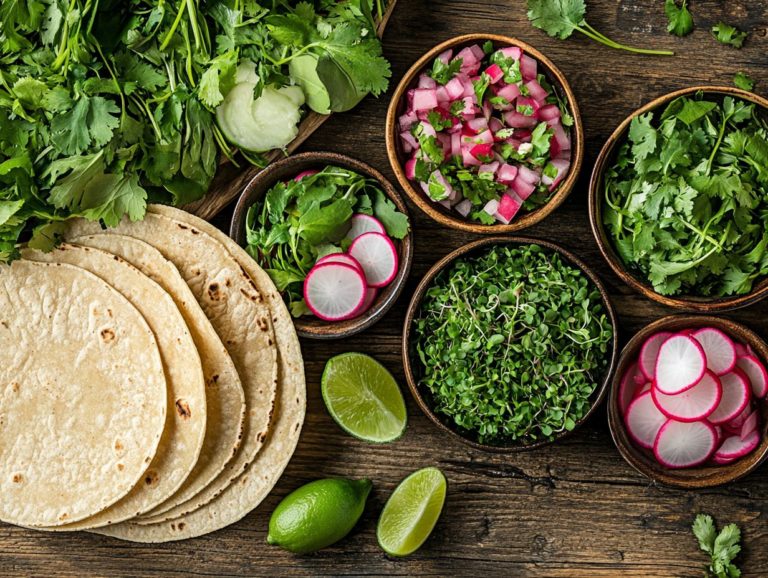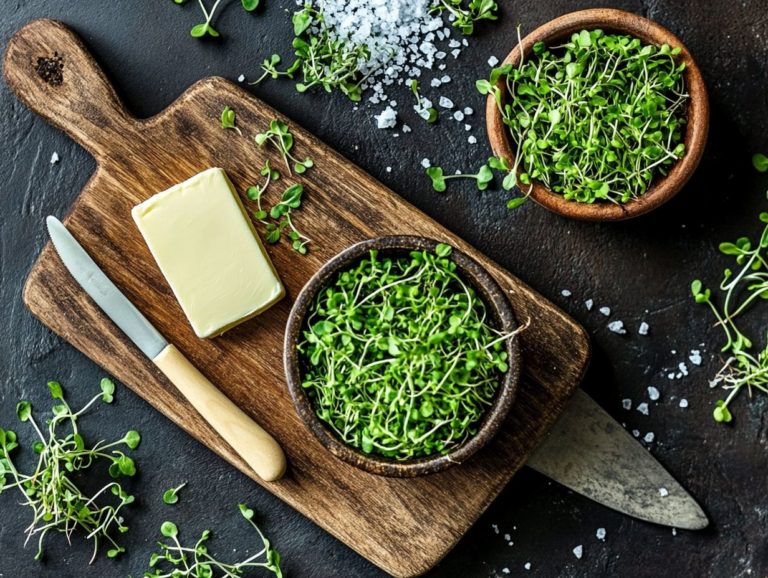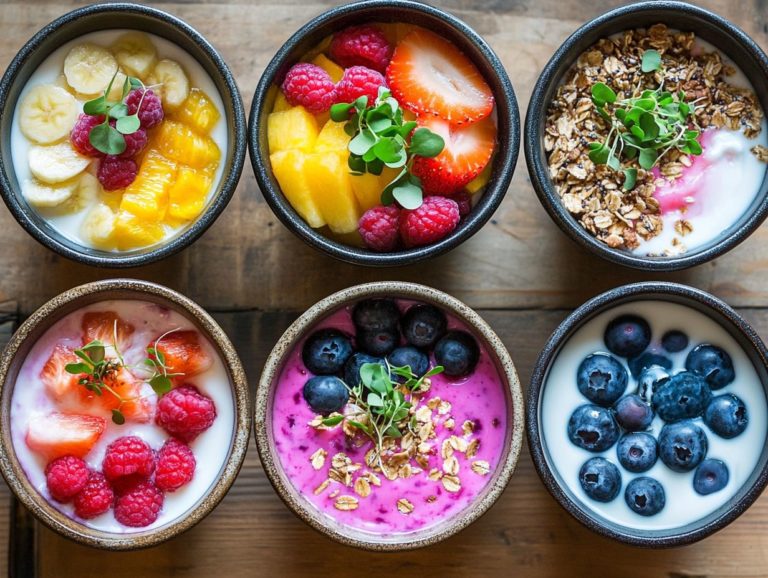66. Microgreens for Flavor: Best Recipes to Try
Microgreens have transformed the culinary landscape. They are petite, nutrient-dense plants that elevate the flavor of your dishes and enhance their nutritional value.
Explore what microgreens are and their myriad health benefits. You can seamlessly incorporate various types into your cooking. This journey includes delightful recipes, a step-by-step guide to cultivating them at home, and essential tips for handling and storing these vibrant greens.
Whether you re a seasoned chef or just starting in the kitchen, microgreens are destined to elevate your culinary creations to new heights.
Contents
- Key Takeaways:
- What are Microgreens?
- Benefits of Using Microgreens in Cooking
- Types of Microgreens to Use in Cooking
- Best Recipes to Try with Microgreens
- How to Grow Your Own Microgreens
- Tips for Using Microgreens in Cooking
- Potential Risks and Precautions
- Frequently Asked Questions
- What are microgreens and why are they great for adding flavor?
- What are some popular microgreens to use for flavor?
- What are some delicious recipes to try using microgreens for flavor?
- How do I store microgreens to keep them fresh?
- Can I grow my own microgreens at home?
- Are there any health benefits to eating microgreens for flavor?
Key Takeaways:
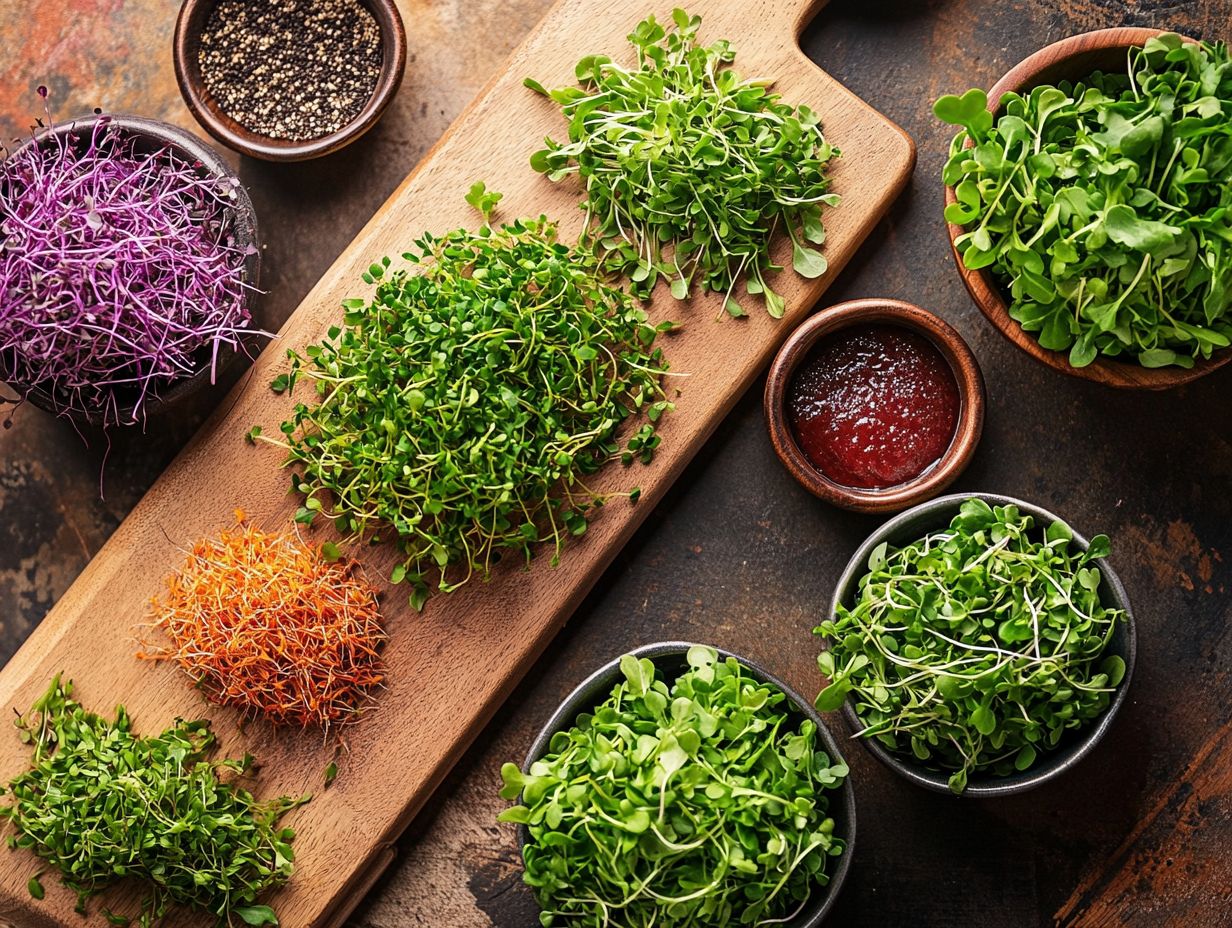
- Microgreens add a burst of flavor to any dish.
- They enhance nutritional value, offering a boost to your meals.
- Popular varieties like arugula and broccoli are easy to use in delicious recipes.
What are Microgreens?
Microgreens are young edible greens that you harvest just after the first true leaves appear. These vibrant plants are not just tasty; they pack a nutritious punch.
Packed with essential vitamins like A, C, E, and K along with antioxidants, microgreens play a significant role in health-conscious diets. Urban gardeners and chefs have embraced unique microgreens to elevate your dishes for their distinct flavors and striking colors, making them a staple of gourmet cooking and a sought-after choice in contemporary cuisine.
Definition and Nutritional Content
Microgreens are delightful young seedlings of vegetables and herbs that you can harvest within 7 to 21 days of germination. They are a fresh and flavorful addition to any meal.
These tiny greens are not just cute; they pack a powerful nutritional punch. Often, they boast higher concentrations of vitamins, minerals, and antioxidants than their fully grown counterparts. For instance, broccoli microgreens are rich in sulforaphane, a natural compound known for its cancer-fighting properties. Radish microgreens bring a spicy kick to the table and are high in vitamin C. To explore more about the microgreen varieties for culinary professionals, consider incorporating them into your dishes for added flavor and nutrition.
Incorporating these vibrant greens into your breakfast smoothies or topping your omelets with them enhances the nutritional profile and adds a burst of color and flavor. They can elevate salads, sandwiches, and even wraps, transforming everyday dishes into culinary masterpieces.
Benefits of Using Microgreens in Cooking
Incorporating microgreens into your cooking elevates the flavor profile of your dishes. They introduce unique and aromatic tastes that invigorate your palate.
Beyond their delightful flavors, these vibrant greens significantly enhance the nutritional value of your meals. They offer a concentrated source of vitamins, nutrients, and health benefits that energize your cooking.
This infusion of goodness energizes your meals, especially at breakfast, turning a simple meal into a powerhouse of nourishment.
Enhancing Flavor and Nutritional Value
Microgreens are a remarkable way to elevate both the flavor and nutritional profile of your dishes. They infuse your meals with fresh, earthy tones, turning everyday experiences into gourmet ones.
Consider the peppery kick of arugula microgreens; they can truly enhance salads and sandwiches. Or think about the delicate sweetness of sunflower microgreens, which pairs beautifully with grain bowls and stir-fries. For a deeper understanding of these flavors, check out the microgreen varieties: taste and flavor guide. Packed with vitamins A, C, and K along with potent antioxidants, these tiny greens offer a significant boost to your health and wellness.
Picture avocado toast with radish microgreens or a beet salad topped with basil microgreens. They not only make your plate look stunning but also deliver a complex flavor profile that delights the palate. Whether you’re crafting soups or seafood dishes, incorporating microgreens into your diet can elevate both the presentation and nutrition of any recipe.
Types of Microgreens to Use in Cooking

You ll find an array of popular microgreens that can elevate your dishes, each bringing its own unique flavor and character.
These vibrant greens enhance fresh salads, hearty sandwiches, invigorating smoothies, and savory omelets.
Popular Varieties and Their Uses
Popular microgreen varieties like radish, broccoli, and sunflower infuse your meals with vibrant colors and deliver unique flavors and health benefits.
Radish microgreens provide a spicy kick, transforming salads and sandwiches into something special. Broccoli microgreens have a mild, earthy taste, blending effortlessly into smoothies or serving as a nutrient-dense topping for omelets. Sunflower microgreens boast a delightful nutty flavor, perfect for stirring into stir-fries or as a garnish for soups. To further enhance the flavor of your microgreens, explore ways to enhance flavor in microgreens.
To maximize the benefits of these vibrant greens, add them towards the end of the cooking process. This way, you ll retain their delightful crunch and health benefits, ensuring every meal is flavorful and nutritious. This simple technique enhances the look and taste of your dishes.
Best Recipes to Try with Microgreens
When incorporating microgreens into your culinary creations, you’ll discover a wealth of exquisite recipes that elevate flavors and health benefits.
Breakfast serves as an ideal canvas for this exploration. Experiment with delightful options such as:
- Smoothies
- Omelets
- Toast
- Gourmet pancakes
Simple and Delicious Ideas
Incorporate microgreens into your meals for a burst of flavor and nutrition. Add them to breakfast smoothies, omelets, or as toppings on toast.
To elevate your morning smoothie, blend a handful of microgreens like spinach or kale with bananas and berries. This enhances the nutritional profile and adds a refreshing taste.
For omelets, whisk in a variety of microgreens directly into the eggs or sprinkle them on top just before serving for a beautiful presentation.
For toast, start with a base of creamy avocado or hummus, then layer on the microgreens for extra texture and nutrients. Experiment with spicy microgreens for a kick or choose milder varieties to suit different tastes.
These simple methods ensure you enjoy your meals while boosting your intake of essential vitamins.
How to Grow Your Own Microgreens
Growing your own microgreens at home is fun and easy! It allows you to savor fresh, nutrient-dense greens directly from your indoor garden, making it an ideal endeavor for urban gardeners and health-conscious enthusiasts alike.
Don’t miss out on the chance to grow fresh, nutritious greens right in your kitchen!
Step-by-Step Guide to Growing at Home

To successfully grow microgreens at home, follow a few simple steps: select the right seeds, prepare your growing medium, and provide adequate light and moisture.
With many seed varieties available, it’s crucial to understand which ones thrive indoors. Leafy types like kale and radish are excellent choices for beginners. Herbs such as basil and cilantro flourish and elevate your meals with fresh flavors, making them perfect for urban gardening.
When preparing your growing medium, consider using organic soil blends or coir. These options provide ample nutrients for your microgreens. Aim for at least 12 hours of light each day from natural sunlight or grow lights. This light is essential for plants to convert light into energy.
Getting the moisture just right is key for success. Over-watering can lead to mold. A spray bottle is perfect for gentle hydration. For common challenges like pests or inconsistent growth, regular monitoring and adjusting conditions can make a significant difference.
The thrill of harvesting vibrant greens from your kitchen makes this effort truly rewarding.
Tips for Using Microgreens in Cooking
Incorporating microgreens into your dishes enhances both flavor and nutrition. To unlock their potential, use proper handling and storage techniques. This keeps them fresh and enhances the visual and taste appeal of your meals.
Proper Storage and Handling
Storing and handling microgreens correctly is vital for preserving their freshness and nutritional value. This ensures they remain a delightful addition to your meals.
To maximize their culinary potential, keep these delicate greens in a cool environment, ideally between 32 F and 41 F. Use breathable containers like perforated plastic bins or paper bags to maintain the right humidity and prevent excess moisture that could lead to spoilage.
When handling microgreens, treat them with care. Avoid crushing or bruising them; gently lift them out of the container to minimize damage. For the best flavor and nutrient retention, consume them within a week. A simple trick is to store them with a damp paper towel to help extend their shelf life. Additionally, consider exploring must-try microgreen varieties for salads to enhance your dishes.
Potential Risks and Precautions
While microgreens are typically safe and nutrient-rich, be aware of potential risks and take necessary precautions. This includes being mindful of allergies and ensuring that proper hygiene practices are followed during preparation.
Allergies and Contamination Concerns
Awareness of allergies and contamination concerns is essential when incorporating microgreens into your diet. This knowledge ensures safe consumption and maximizes the health benefits.
Certain microgreens, such as arugula and mustard greens, may contain allergens that can trigger reactions in sensitive individuals. Improper handling and storage can lead to mold or bacteria growth, jeopardizing food safety.
To minimize these risks, choose microgreens from reputable growers who prioritize safety protocols.
When preparing these delicate greens, wash them thoroughly under running water. This significantly reduces surface contaminants. Even soaking them for a few minutes can help dislodge potential allergens and debris, ensuring every bite is both nutritious and safe.
Frequently Asked Questions
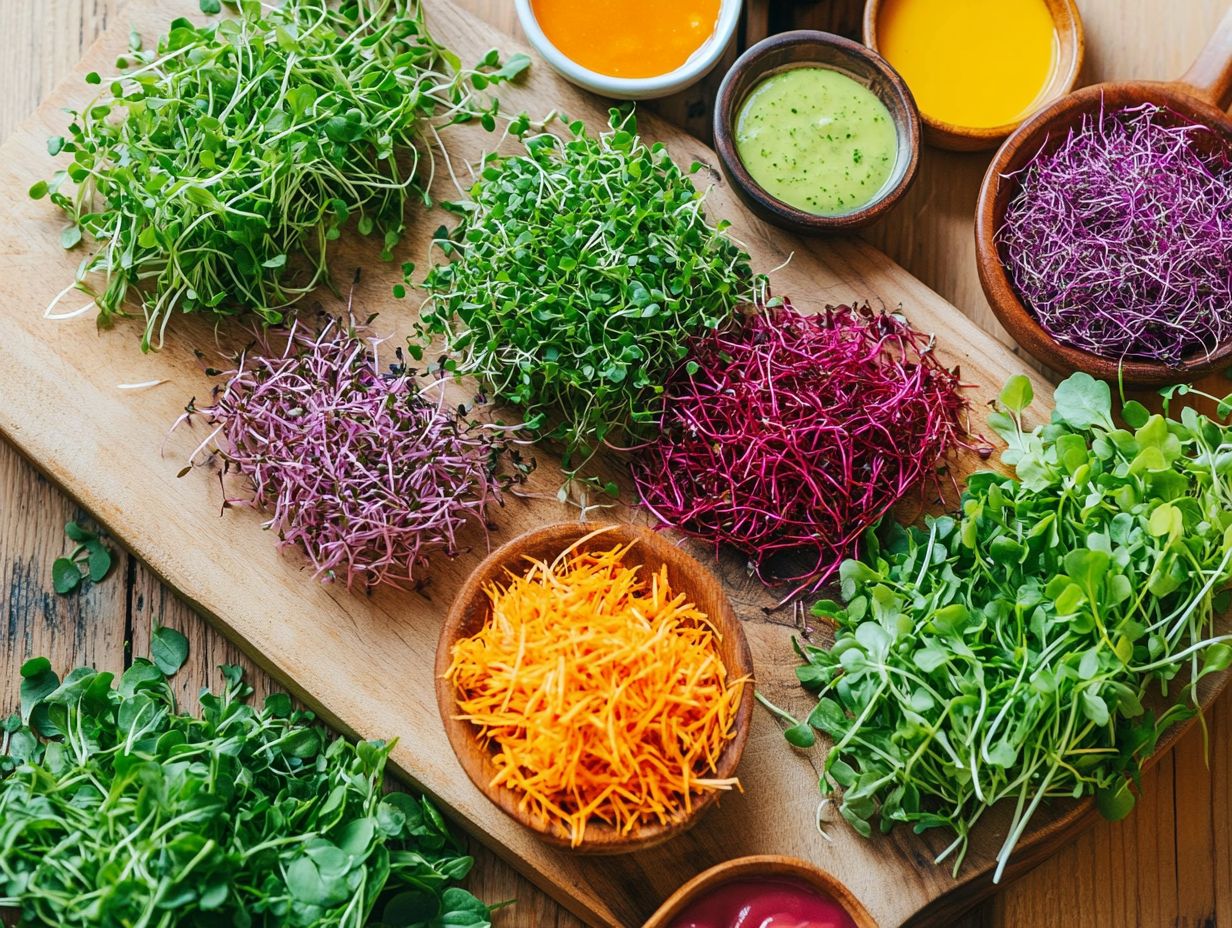
What are microgreens and why are they great for adding flavor?
Microgreens are young vegetable greens harvested when they are only a few inches tall. Packed with nutrients and concentrated flavor, they are ideal for adding a burst of taste to any dish.
Start your home garden journey today and enjoy fresh flavors in your cooking!
What are some popular microgreens to use for flavor?
Microgreens are young plants harvested just after the first leaves have developed. Some popular varieties for flavor include arugula, radish, mustard, cilantro, and basil. Each type offers a unique flavor profile, so feel free to experiment with different options!
What are some delicious recipes to try using microgreens for flavor?
There are many tasty recipes to try, such as microgreen pesto pasta, a microgreen and feta frittata, microgreen and avocado toast, and a microgreen and smoked salmon salad.
You can also use microgreens to top soups, sandwiches, and wraps for an extra flavor boost!
How do I store microgreens to keep them fresh?
Keep your microgreens fresh and bursting with flavor! Store them in a sealed container or plastic bag in the refrigerator. They should last for about a week, but for optimal taste, it’s best to use them within a few days.
Can I grow my own microgreens at home?
Absolutely! Growing your own microgreens at home is easy and rewarding. You only need a shallow container, potting soil, and seeds. They don t require much space or sunlight, making them a perfect choice for those with limited gardening options.
Are there any health benefits to eating microgreens for flavor?
Yes! Microgreens are not only flavorful but also packed with nutrients. They are rich in vitamins, minerals, and antioxidants, making them a fantastic addition to any healthy diet.
Start experimenting with microgreens today and elevate your dishes with fresh flavors!


